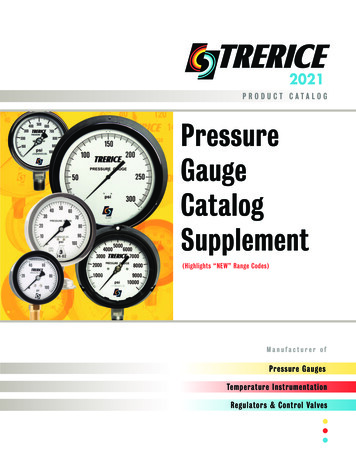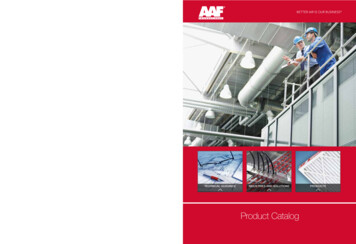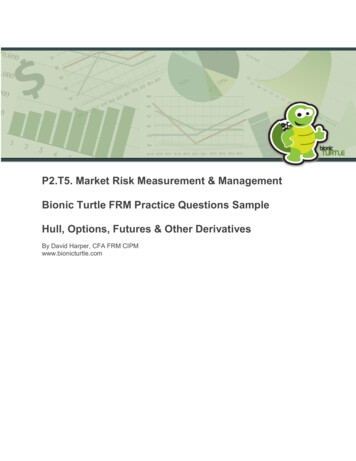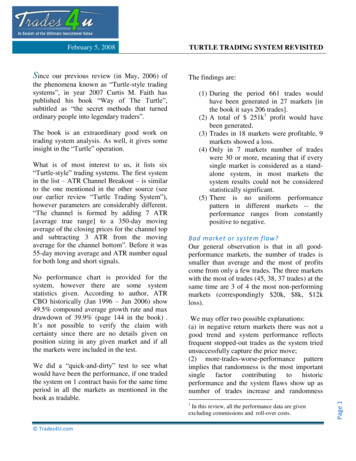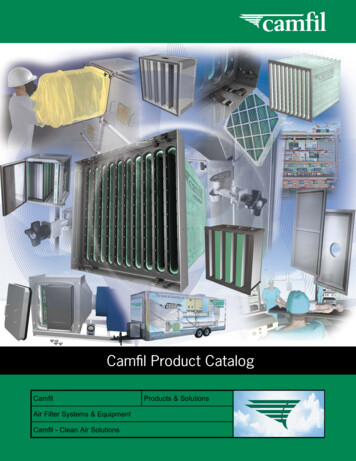
Transcription
Camfil Product CatalogCamfilAir Filter Systems & EquipmentCamfil - Clean Air SolutionsProducts & Solutions
Throughout this catalog, you will find references to productliterature identifiers (4 digits) that offer additional details onspecific products. All of our product literature is available inour online library y/You can also contact Camfil at (866) 422-6345 orliterature@camfil.com to request a copy.Product literature is also available on our web site througha link on each product web page. Camfil USA 2014www.camfil.comwww.camfil.us
Commitment to quality.Camfil is the leader in clean air technologyand air filter protection.Camfil has its own product development,R&D and worldwide local representation.Our overall quality goal is to develop,produce and market products and servicesof such a quality that we aim to exceed ourcustomers expectations.We see our activities and products as anexpression of our quality.To reach a level of total quality, it isnecessary to establish an internal workenvironment where all Camfil employees cansucceed together. This means an environmentcharacterized by openness, confidence andgood business understanding.www.camfil.comCorporate OfficesCamfil ABCamfil USACamfil CanadaSveavägen 56 E1 North Corporate Drive2785 Francis Hughes AvenueSE-111 34 Stockholm, SwedenRiverdale, NJ 07457Laval Quebec H7L3J6Tel: 46 8 545 12 500Tel: 973-616-7300Tel: 450-629-3030Fax: 46 8 24 96 50Fax: 973-616-7771Fax: 450-662-6035North American Manufacturing LocationsConcord, OntarioConover, North Carolina Corcoran, CaliforniaCrystal Lake, IllinoisRiverdale, New Jersey Washington, North CarolinaWorldwide Manufacturing SwedenSwitzerlandUnited Kingdom
Conover NC, Corcoran CA, Crystal Lake IL, Riverdale NJ,Washington NC, Concord OntarioUnited States Tel: (866) 422-6345, Canada Tel: (800) 976-9382www.camfil.com1Air Filter TechnologyCamfil SolutionsPrefilters MERV 4-13Bag & Rigid Filters MERV 915HEPA/ULPA Filters & FilterModulesCarbon, Chemical Filters &HousingsPharmaseal Fan Filter Unit (FFU) 92City-Flo 94CityCarb 95CamSorb CH Loose-Fill V-Cell Cartridge Filter96CamSorb Riga-Carb 97CamCarb Cylinders 98CamSorb 1" CF Panel 99CamSorb RS25D 2" Panel 100CamSorb RS80 Panels 101CamPure GDM300 102CamPure GDM440 103HEGA Filter Module 104CamCarb Green 105CamCarb Cylinder Holding Frame 106CamSorb CF4A Modular Assemblies 107CamSorb RS Retainer/Pack Modular Assemblies108CamCarb Cylinder SMH Glide/Pack 109CamSorb 3CF Glide/Pack 110CamSorb RS Glide/Pack 111FastFrame 114Type 8 Built-up Bank Filter Holding Frame 115Fasteners 116Magna-Grid 118Magna-Frame II 119Magna-Frame III 120Absolute Prefilter Kits 121GlidePack MultiTrack 25 122GlidePack MultiTrack 13 123GlidePack UniTrack 1243P Glide/Pack 1254P Glide/Pack 126V-Bank Glide/Pack 127Diffuser/Pack 128ECO Moisture/Pack 129Dynavane Inertial Air Cleaner 130Sidelock 133Magna/Pack 134CamContain 135CamContain FB Housing (fluid seal) 136CamContain GB Housing (gasket seal) 141CamContain FN Housing (fluid seal) 146CamContain GN Housing (gasket seal) 150CamContain PB Prefilter Housing 154CamContain FB-R Round Housing 156CamContain Test Sections 157Filter Frames & HousingsAs part of our program for continuous improvement, Camfil reserves the right to change specifications without notice.IAQ 4Selecting the Proper Filter 7ASHRAE Standard 52.2 14HEPA Filter Testing 16UL Filter Testing 19Energy Cost Index (ECI) 2030/30 4030/30 SA 42Aeropleat III 43Aeropleat IV 45AP-Eleven 47AP-Thirteen 49Type 44 50ECO Moisture Separator 52Hi-Flo ES 54Cam-Flo XLT 56Hi-Flo 57S-Flo 59City-Flo XL 60Durafil ES 61Durafil ESB 62Durafil 2V 63Riga-Flo 64Riga-Flo PH 65Riga-V 66Riga-V PH 67Aeropac 68Opti-Pac 70XS Absolute 72XH Absolute 73PS Absolute 74PH Absolute 75Micretain 76Absolute V-G 77Filtra 2000 Absolute 78Filtra 2000 GEL Absolute 79Sofilair Green 80K Absolute 81F Absolute 82Termikfil 2000 Absolute 83E-PTFE Megalam 84Ultra-Pac Absolute 85Megalam Mini-Pleat Panel Filters 86Megalam Terminal Diffuser 88Slimline DCM-FD 89Slimline RSR 90Pharmaseal 91
A i r F i l t e r Te c h n o l o g yAirborne Contaminants and Indoor Air QualityIAQConcern over the quality of air inside of buildings is nowreceiving the attention that the quality of outside air received inthe 1970’s. Acceptable indoor air quality (IAQ) is defined in theAmerican Society of Heating, Refrigerating, and AirConditioning Engineers (ASHRAE) Standard 62.1: Ventilationfor Acceptable Indoor Air Quality as: "Air in which there are noknown contaminants at harmful concentrations and with whicha substantial majority of the people exposed do not expressdissatisfaction." It is clear, in many areas of the country, and inmany buildings, we have a problem under this definition.Estimated potential productivity gains from Improved Indoor Environments (1996 US Dollars).Source of productivity gainPotential annual health benefitsReduced respiratory illness16–37 million avoided cases of common cold or influenzaReduced allergies and asthma10–30% decrease in symptoms in 53 million allergy sufferers and 16 millionasthmaticsReduced sick building syndrome (SBS) symptoms20–50% reduction in SBS health symptoms experienced frequently at work by 2.15million workersPoor IAQ has been shown to result in increased incidence ofillness and absenteeism, reduced productivity, irritability,complaints about building odor and stuffiness, and healthproblems. These may include allergies, coughing, diarrhea, eye,nose, and throat irritation, fatigue, general respiratoryproblems, headaches, nausea, dizziness, runny nose, and skinirritation. Some contaminants enter a building from theoutside, while others are generated internally. Often, theseproblems appear one to two hours after the occupants arrive atthe building and disappear one or two hours after they leave thebuilding. A slight cold can persist for weeks or even months.The culprit is often the continuous exposure to excessive levelsof contaminants.Atmospheric air has hundreds of thousands of particles per cubic foot. In many areas,it does not make sense to introduce contaminant laden air into a building. It makessense to re-circulate clean, filtered air.Some common atmospheric contaminants relative to a human hair.Studies have shown that we should be concerned aboutrespirable size particles, those that can penetrate deep into thelungs and do damage. ASHRAE addresses this in their Standard62.1, and the United States Environmental Protection Agency(EPA) provides actual air quality data on a daily basis in manylocations throughout the United States because of immediatehealth concerns when levels are elevated. These lung-damagingparticles are 0.2 to 5.0 micrometers in size. Larger particlesare filtered by the body’s natural protection system in the nose,the throat and trachea before they can penetrate deeper intothe lungs.Smaller particles, less than 1-micron in size, because of theirphysical properties can penetrate deep into the lungs and reachbronchioles, bronchi, and the critical alveoli. Most maladies,including infections, occur in the lungs. Ninety-nine percent ofall airborne particles are under 1-micron in size with the typicalair sample having hundreds of thousands of these potentiallydamaging particles in each cubic foot of air. This critical submicron particle range should be the focus of our particulatecontamination concerns.Conover NC, Corcoran CA, Crystal Lake IL, Riverdale NJ,Washington NC, Concord OntarioUnited States Tel: (866) 422-6345, Canada Tel: (800) 976-9382www.camfil.com4As par t of our program for continuous improvement, Camfil reserves the right to change specifications without notice.Fisk WJ. Estimates of potential nationwide productivity, and health benefits from better indoor environments: an update. In: Spengler JD, Samet JM, McCarthy JF, eds. Indoor AirQuality Handbook. New York: McGraw-Hill; 2001: 4.1–4.36.
Bacillus anthracis1.1/spherical spores-5MERV 6 MERV 8 MERV 10 MERV 13 MERV 15 MERV 1615.536.739.296.399.9 99.9 TB bacilli064 x 1 /rod7.418.119.578.69898.1Smallpox virus0.22/complex capsid3.77.47.939.66870.7Influenza A virus0.098/helical6.211.21246.27179Kowalski, WJ, Bahnfleth WP. Immune-building technology and bioterrorism defense. HPAC Engineering, Jan 2003.People spend more than 90 percent of their time indoors - athome or work, in shopping centers, or vehicles. This leads toexposure to harmful air contaminants, thus having atremendous impact on our health, and productivity.As part of our program for continuous improvement, Camfil reserves the right to change specifications without notice.During the last 20 years, researchers have explored therelationship between IAQ, health and productivity. Please reviewthe following examples:1.2.3.4.In a survey of 100 U.S. office buildings, 23 percent of office workers experienced frequent symptoms of Sick Building Syndrome (SBS) such as respiratory ailments, allergies, and asthma. The impact has usually beenhidden in sick days, lower productivity, and medical costs. The economicimpact is enormous, with an estimated decrease in productivity around 2percent nationwide, resulting in an annual cost to the United States ofapproximately 60 billion.William Fisk, from Lawrence Berkeley National Laboratory in California,was one of the early researchers to examine IAQ effects on health andproductivity. In a recent article, he established a baseline for quantifyingbenefits from improved IAQ and demonstrated the economic impacts ofincreased productivity. Findings are showing that improvement in IAQcan:- Reduce SBS symptoms by 20 to 50 percent, with estimated savings of 10 to 100 billion- Reduce asthma by 8 to 25 percent, with estimated savings of 1 to 4billion- Reduce other respiratory illnesses by 23 to 76 percent, with estimatedsavings of 6 to 14 billion- Improve office worker productivity by 0.5 to 5 percent, with estimatedsavings of 20 to 200 billionA recent study by Bjarne Olsen, chairperson for the International Centerfor Indoor Environment and Energy (ICIEE) in Denmark, indicated thatimproved thermal comfort, reduction in indoor pollutants, enhanced ventilation rates, and ventilation effectiveness can increase productivity by 5 to10 percent. Conversely, the research also indicates that a 10 percentdecrease in tenant satisfaction with IAQ results in a 1 percent drop in productivity.Pawel Wargocki, also from the ICIEE, conducted three separate studiesshowing an increase of productivity at 5 percent or more through IAQimprovements.Clearly, productivity gains cannot be projected the way thatenergy savings can be, but research strongly suggests that theinvestment in a high-performance IAQ building pays off inoccupant productivity.What Causes Poor IAQ?Poor IAQ is caused by airborne particulates and gases orvapors that adversely affect occupant health and comfort, thebuilding structure, or its furnishings. Some IAQ problems,called "sick building syndrome," are new and are the result ofchanges in HVAC system design and operating practices; othershave existed for years, but building occupants are only nowcomplaining about them. Air quality problems in buildings areusually related to the following pollutants: Particulates including airborne dirt, dust, lead, or asbestos Volatile organic compounds (VOCs), including chemicals, suchas formaldehyde or other gases from building materials,carpets, furniture, or ozone from copiers and other officeequipment Biological contaminants including bacteria, mold, and mildewthat come from contaminated air handling systems, books,carpets, etc., usually related to unacceptably high levels ofmoisture or humidity Bioeffluents, or other contaminants, both gaseous andparticulate, generated by the building occupantsMicroorganisms are a leading source of contamination. Theseinclude bacteria, fungi, yeast, and algae. They are foundeverywhere and can cause human and building maintenanceproblems. Microorganisms are present on all environmentalsurfaces (including humans), in the air, and in water associatedwith normal building operation. Like humans, microorganismsneed two things to live -- moisture and nutrients. Givenacceptable growth conditions, microorganisms can multiplyfrom one or two organisms to more than 1 billion organisms injust 18 hours. In most cases, problems relating tomicroorganisms can be addressed by proper control ofmoisture and humidity. Removing one or the other will usuallyeliminate these nuisances. A properly maintained and correctlyConover NC, Corcoran CA, Crystal Lake IL, Riverdale NJ,Washington NC, Concord OntarioUnited States Tel: (866) 422-6345, Canada Tel: (800) 976-9382www.camfil.com5Camfil SolutionsAverage Size (microns)/shapePrefilters MERV 4-13OrganismHEPA/ULPA Filters & Filter Bag & Rigid Filters MERV 9-15ModulesThe following chart notes some common airborne pathogens, their relative size and a removal efficiency based upon the MERV of afilter.Carbon, Chemical Filters &Housingsdeposits stay there and cause damage over long periods oftime. Sources include diesel bus and truck emissions as well asordinary auto exhausts, industrial and utility smokestacks,mining, and construction. The researchers analyzed data from500,000 adults who were surveyed as part of an ongoing cancerstudy from 1982 to 1998. They have calculated that thenumber of deaths from lung cancer increases by 8 percent forevery 10 micrograms of fine particle matter per cubic meter.Filter Frames & HousingsAirborne Contaminants and Indoor Air QualityA recent study in the Journal of the American MedicalAssociation (JAMA) Vol. 287, No. 9: 1132-1141, provides themost definitive research to date, linking tiny soot particles withlung cancer. Researchers looked at the impact of soot particlessmaller than 2.5 microns in cities throughout the United States.Particles this small are easily drawn into the alveoli, t
5 Filter Frames & Housings Conover NC, Corcoran CA, Crystal Lake IL, Riverdale NJ, Washington NC, Concord Ontario United States Tel: (866) 422-6345, Canada Tel: (800) 976-9382 www.camfil.com As part of our program for continuous improvement, Camfil reserves the right to change specifications without notice. A recent study in the Journal of the American Medical Association (JAMA) Vol. 287, No .
